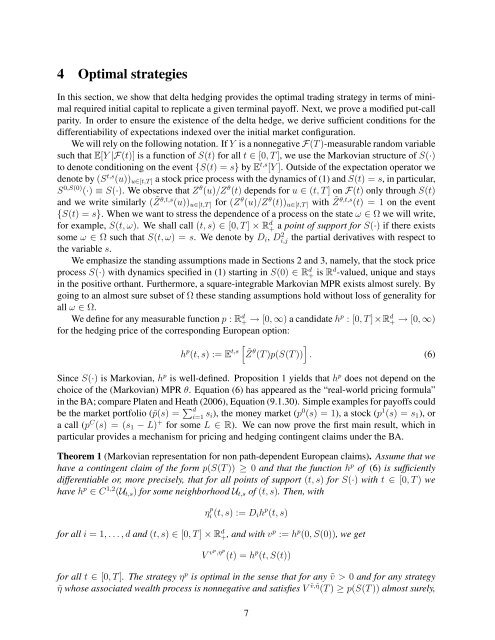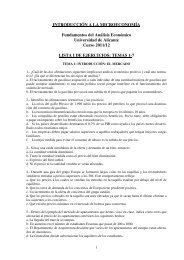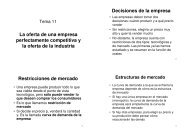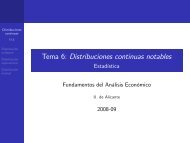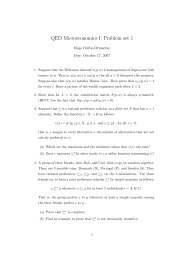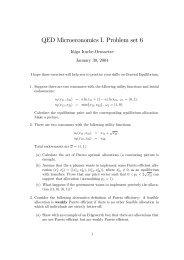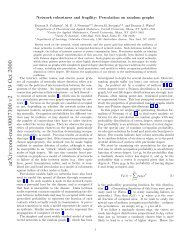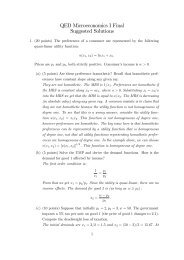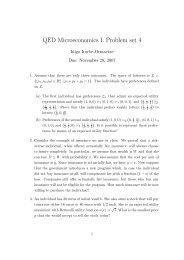Hedging under arbitrage
Hedging under arbitrage
Hedging under arbitrage
Create successful ePaper yourself
Turn your PDF publications into a flip-book with our unique Google optimized e-Paper software.
4 Optimal strategies<br />
In this section, we show that delta hedging provides the optimal trading strategy in terms of minimal<br />
required initial capital to replicate a given terminal payoff. Next, we prove a modified put-call<br />
parity. In order to ensure the existence of the delta hedge, we derive sufficient conditions for the<br />
differentiability of expectations indexed over the initial market configuration.<br />
We will rely on the following notation. If Y is a nonnegative F(T )-measurable random variable<br />
such that E[Y |F(t)] is a function of S(t) for all t ∈ [0, T ], we use the Markovian structure of S(·)<br />
to denote conditioning on the event {S(t) = s} by Et,s [Y ]. Outside of the expectation operator we<br />
denote by (St,s (u))u∈[t,T ] a stock price process with the dynamics of (1) and S(t) = s, in particular,<br />
S0,S(0) (·) ≡ S(·). We observe that Zθ (u)/Z θ (t) depends for u ∈ (t, T ] on F(t) only through S(t)<br />
and we write similarly ( ˜ Zθ,t,s (u))u∈[t,T ] for (Zθ (u)/Z θ (t))u∈[t,T ] with ˜ Zθ,t,s (t) = 1 on the event<br />
{S(t) = s}. When we want to stress the dependence of a process on the state ω ∈ Ω we will write,<br />
for example, S(t, ω). We shall call (t, s) ∈ [0, T ] × Rd + a point of support for S(·) if there exists<br />
some ω ∈ Ω such that S(t, ω) = s. We denote by Di, D2 i,j the partial derivatives with respect to<br />
the variable s.<br />
We emphasize the standing assumptions made in Sections 2 and 3, namely, that the stock price<br />
process S(·) with dynamics specified in (1) starting in S(0) ∈ Rd + is Rd-valued, unique and stays<br />
in the positive orthant. Furthermore, a square-integrable Markovian MPR exists almost surely. By<br />
going to an almost sure subset of Ω these standing assumptions hold without loss of generality for<br />
all ω ∈ Ω.<br />
We define for any measurable function p : Rd + → [0, ∞) a candidate hp : [0, T ]×R d + → [0, ∞)<br />
for the hedging price of the corresponding European option:<br />
h p (t, s) := E t,s<br />
� �<br />
˜Z θ<br />
(T )p(S(T )) . (6)<br />
Since S(·) is Markovian, h p is well-defined. Proposition 1 yields that h p does not depend on the<br />
choice of the (Markovian) MPR θ. Equation (6) has appeared as the “real-world pricing formula”<br />
in the BA; compare Platen and Heath (2006), Equation (9.1.30). Simple examples for payoffs could<br />
be the market portfolio (˜p(s) = � d<br />
i=1 si), the money market (p 0 (s) = 1), a stock (p 1 (s) = s1), or<br />
a call (p C (s) = (s1 − L) + for some L ∈ R). We can now prove the first main result, which in<br />
particular provides a mechanism for pricing and hedging contingent claims <strong>under</strong> the BA.<br />
Theorem 1 (Markovian representation for non path-dependent European claims). Assume that we<br />
have a contingent claim of the form p(S(T )) ≥ 0 and that the function h p of (6) is sufficiently<br />
differentiable or, more precisely, that for all points of support (t, s) for S(·) with t ∈ [0, T ) we<br />
have h p ∈ C 1,2 (Ut,s) for some neighborhood Ut,s of (t, s). Then, with<br />
η p<br />
i (t, s) := Dih p (t, s)<br />
for all i = 1, . . . , d and (t, s) ∈ [0, T ] × R d +, and with v p := h p (0, S(0)), we get<br />
V vp ,η p<br />
(t) = h p (t, S(t))<br />
for all t ∈ [0, T ]. The strategy η p is optimal in the sense that for any ˜v > 0 and for any strategy<br />
˜η whose associated wealth process is nonnegative and satisfies V ˜v,˜η (T ) ≥ p(S(T )) almost surely,<br />
7


